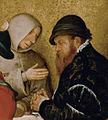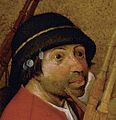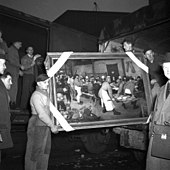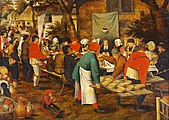The peasant wedding
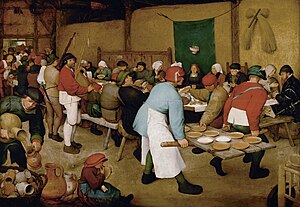
|
| The peasant wedding |
|---|
| Pieter Bruegel the Elder , around 1568 |
| Oil on oak |
| 114 × 164 cm |
| Kunsthistorisches Museum Vienna |
The Peasant Wedding ( Dutch De Boerenbruiloft ) is a painting by the Flemish painter Pieter Bruegel the Elder .
Content and description
The picture is a realistic representation of a peasant wedding party in Flanders at the end of the 16th century. In contrast to his perspective in earlier works, Bruegel dispenses with the overview here , but shows what is happening directly from eye level. There is a lively crowd at the white table in a large barn. The guests sit on sturdy wooden benches without backs and on simple stools. On the straw wall behind the bride hangs a green cloth on which the paper bridal crown is attached. She is sitting alone in the middle of the table, eyes downcast and hands folded. She is not allowed to eat or speak. The bridegroom cannot be determined, but according to the custom of the time, he does not sit at the table. He is possibly the man who fills wedding beer into smaller mugs on the left edge of the picture, but who in turn can also be a servant of the squire (far right).
On a wooden door, two men bring filled, flat wide plates. The Front is color, the greatest sized figure and the blue jacket contrasting designed. With him, the half- diagonals of the front rows of seats meet , the back pieces of his apron show the central axis . The second carries a wooden spoon on his hat and can thus be recognized as a migrant worker. A man sitting at the front of the table passes the plates to the guests. The notary sits in the high armchair in a fur-trimmed jacket. To the right of it, a Franciscan gives absolution to the landlord, who is sitting in front of him with folded hands , while his dog peeks out from under the table. Two bagpipers provide music , one of whom looks longingly after the meal. In the foreground, a child is licking an empty bowl. Back then, spoons were round (today's oval shape did not appear until much later) and knives were regarded as versatile tools, and the child in the foreground also carries one of them.
Motive and interpretation
He came with the bride is a Flemish proverb, if someone is not working, the bride was also not allowed to do anything at the table, nor to eat or speak. However, the work remains present through the straw wall and the crossed sheaves with rakes . The groom is missing because he was traditionally not allowed to be present at the wedding table. The eating and drinking peasants may be amusing, but there is some evidence that Bruegel had serious intentions. A popular biblical motif was around the 16th century the wedding of Cana ( Jn 2 : 1–12 EU ), during which Jesus turned water into wine. In such depictions, not only is there always a dinner party to be seen, but also a man who fills jugs - as in Bruegel's picture at the front left. In addition, ridicule was especially common in prints.
history
In 1594, Archduke Ernst acquired The Peasant Wedding in Brussels . It later moved to Prague to the collection of Emperor Rudolf II. It survived the Second World War with numerous other art objects in a salt mine in Altaussee . Then she returned to Vienna in October 1945. Today the painting is in the Kunsthistorisches Museum in Vienna , Room X, together with the Tower of Babel , the children's games and the battle between Carnival and Lent . The image was cropped at the bottom at an unknown point in time and later supplemented.
reception
It was pictures like this that gave Pieter Bruegel the nickname “Bauernbruegel”. He describes the wedding with humor, but without the arrogance of the city dweller, but rather conveys a colorful picture of the way of life of the rural population, as it was previously unknown in art.
The Flemish writer and painter Karel van Mander reported on Bruegel's working method in 1604:
“He worked a lot for a businessman, Hans Francken, who was a well-respected and good man and liked to hang out with Brueghel and who met him every day. With this Francken, Brueghel often went out to the farmers, to funfairs and weddings. Disguised as peasants, they brought gifts like the others, pretending they belonged to the bride's clan or country team. Brueghel was delighted to watch the farmers in their way of eating, drinking, dancing, jumping and loving, which he knew how to reproduce in colors in a very funny and pleasant way ... "
In the Tokyo Fuji Art Museum there is a copy that Pieter Brueghel the Younger made in 1630 based on his father's model.
The English author Wendy Beckett writes about the picture:
“At the famous farmer's wedding, the coarse figures, the simple faces and the sometimes inexperienced smile are noticeable, but our amusement, like the Bruegel's, has a bitter aftertaste. This poor, simple young bride is pathetic in her brief hour of triumph, and if the guests gulp down the meal, they are only modest plates of porridge or porridge. And the sparse jewelry cannot hide the fact that the celebration is taking place in the barn. "
Modern popular culture
| There is a festival in the Belgian village ... |
|---|
| Albert Uderzo , 1979 |
| Volume Asterix with the Belgians , p. 47
Link to the picture |
In the comic book Asterix bei der Belgiern , the farmer's wedding appears on the penultimate page as a full-page art quote with the title A festival is taking place in the Belgian village… . In this parody, the draftsman Albert Uderzo replaces the peasants celebrating with the “Belgian” and “Gallic” comic characters known from the book. The original theme of the wedding is missing here, however. The actual drawing was made by Marcel Uderzo .
Individual evidence
- ↑ Klaus Demus , Friederike Klauner , Karl protection: Flemish painting by Jan van Eyck to Pieter Bruegel. Ä. Catalog of the Gemäldegalerie, Kunsthistorisches Museum Vienna . Herold, Vienna 1981, ISBN 3-7008-0208-0 , p. 110.
- ↑ a b Description of the slides in the media package “In the footsteps of the Renaissance and Baroque” ( memento of November 9, 2007 in the Internet Archive ) (PDF; 244 kB) Section: Pieter Bruegel the Elder. Ä .: The wedding dinner, pp. 13 to 14 Retrieved September 25, 2011.
- ↑ a b Kunsthistorisches Museum, Vienna. DVD-ROM: interactive: visit - Gemäldegalerie, 2nd edition 2007 audio commentary on a farmer's wedding ISBN 978-3-902491-09-1 ".
- ^ A b Rose-Marie and Rainer Hagen: Pieter Bruegel the Elder. Ä. - Farmers, fools and demons , Cologne: Benedikt Taschen Verlag GmbH 1999 p. 71 ff.
- ↑ art-magazin.de: Mission Michelangelo ( Memento from September 12, 2017 in the Internet Archive ) (storage location), accessed on September 11, 2017.
- ^ ÖNB, USIS Collection: Description of the picture (return transport), accessed on September 11, 2017.
- ↑ Kunsthistorisches Museum, Vienna. DVD-ROM navigation room 10.
- ↑ Wundram: The most famous paintings in the world
- ↑ Tokyo Fuji Art Museum - Peasant Wedding Feast viewed July 21, 2015.
- ↑ Beckett: The History of Painting
- ↑ see also: Christine Gundermann, 50 Years of Resistance: The Asterix Phenomenon, in: Zeithistorische Forschungen / Studies in Contemporary History, online edition, 6 (2009), no.1
literature
- Wendy Beckett: The History of Painting: 8 Centuries of Occidental Art in 455 Masterpieces . Cologne: DuMont 1995, ISBN 3-7701-3560-1 .
- Rose-Marie Hagen, Rainer Hagen: Masterpieces in Detail: From the Bayeux Tapestry to Diego Rivera. Volume I . Cologne: Taschen 2006, ISBN 3-8228-4787-9 .
- Wieland Schmied (ed.): Harenberg Museum of Painting. 525 masterpieces from seven centuries . Dortmund: Harenberg Lexikon Verlag 1999, ISBN 3-611-00814-1 .
- Manfred Wundram : The most famous paintings in the world . Bergisch-Gladbach: Imprimatur Druck- und Verlagsgesellschaft 1976.

